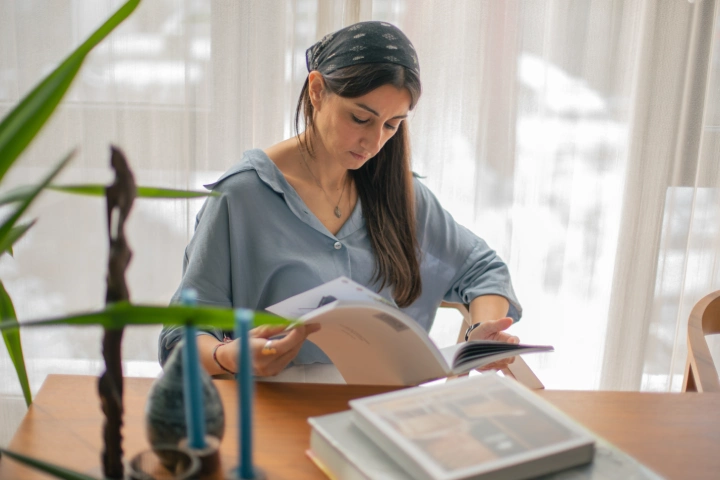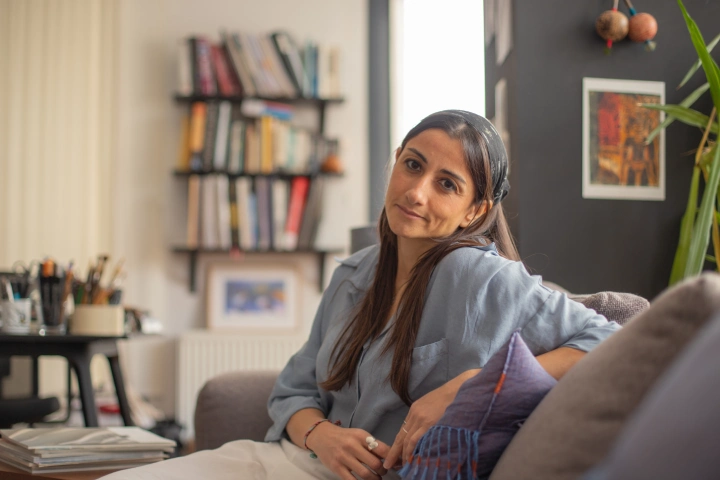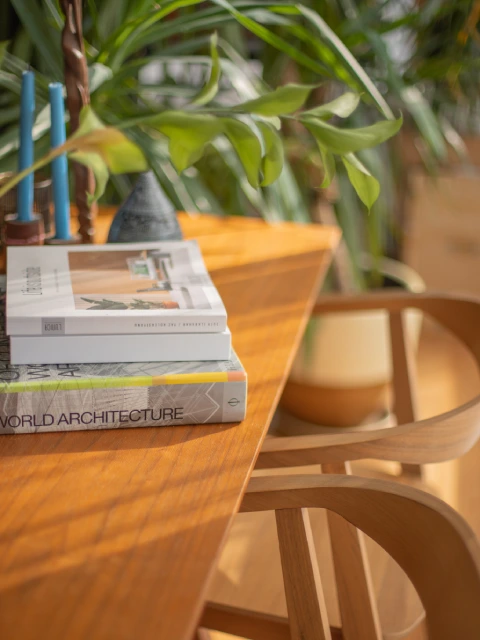Fulden wearing Octavia Pants and Hannah Shirt – Viscose

stories no.19
Fulden Topaloğlu
#womenbehindtheidea
Fulden, a designer with a passion for nature and the sea, has a furniture brand called Studio Kali. We had the chance to visit her in her studio in İstanbul to learn about the processes that inspired her. We asked a few questions to get to know Studio Kali and Fulden.

Fulden wearing Octavia Pants and Hannah Shirt – Viscose
stories no.19
Fulden Topaloğlu
#womenbehindtheidea
Fulden, a designer with a passion for nature and the sea, has a furniture brand called Studio Kali. We had the chance to visit her in her studio in İstanbul to learn about the processes that inspired her. We asked a few questions to get to know Studio Kali and Fulden.
1. Can you tell us a little about Fulden? Do you think you can express and reflect yourself with “Kali”?
My undergraduate education is in industrial engineering. But since I have a great interest in design and creative branches, I did my master’s and doctorate education on industrial product design. In the early years of my career, I worked in different design offices. I also worked as an academician during and after my doctoral education. Before establishing my studio and brand, Studio Kali, I worked as a design group director in a furniture company. When I set aside my education and career-based identities, I am a curious person, in love with nature, especially water and the sea, who loves to travel and is very interested in every subject in the axis of design, art, production, and crafts.
Creating a meaningful, functional, and inspiring world with the products, objects, and experiences I design is what I want most, and what I love most about design is that it is a tool to create such a world. I try to reflect this desire in all Kali’s products, philosophy, and every detail. So, of course, that means expressing myself with Kali.
2. What was it like to move into the field of design after studying engineering? What was the process like to move from a more pragmatic and rational place to a more creative and inner space?
Although it was exciting to make this decision at first, it was also a little scary. But from the moment I started taking my first studio lessons on design and realized the right decision I had made. On the one hand, I also think that my engineering education provides a good background for this field because industrial design is a field at the intersection of these two worlds. Creativity is one of the main inputs, but if you want to make functional products, you have to include rationality, pragmatism, and engineering, especially during the development and transformation into the final product. Therefore, this journey has been such a good synthesis process for me. But I can also say that sometimes projects progress in an intense tension between these two approaches 🙂 A left brain that wants to categorize, group, establish a system and find clear answers, and a right brain that pursues emotional criteria, meaning, poetry, and aesthetic values with discussions and negotiations.

3. How did you decide on the material to use? Was this process difficult for you? How did you overcome the difficulties?
Studio Kali is more than a studio where I do my job, where my passion for design comes together with my interests and the most important values. It’s a world in which understanding, products, and experiences complement each other. Since I look at everything from this perspective, I started with wood, which is my favorite material when choosing the materials I will use, and continued by adding completely natural materials such as metal, wool, and marble. Keeping handmade and crafts alive, producing with natural materials concerning nature, supporting quality craftsmanship and local production are among the core values of Studio Kali. Since I have clearly defined these values from the very beginning, the process of choosing the materials was not difficult at all and came very spontaneously. The difficulties were in finding the masters and producers who could offer the production quality I wanted and whose work ethic and values were compatible with Studio Kali. In this matter, I have progressed as a researcher by consulting the people/institutions that I respect and whose references I trust.
4. Can you tell us how you felt when you wore the Hannah Shirt and Octavia Pant in three words?
Stylish, comfortable, and just like myself.
Many thanks to Atölye Ren for the inclusive philosophy and sustainable stance behind these beautiful outfits!

1. Can you tell us a little about Fulden? Do you think you can express and reflect yourself with “Kali”?
My undergraduate education is in industrial engineering. But since I have a great interest in design and creative branches, I did my master’s and doctorate education on industrial product design. In the early years of my career, I worked in different design offices. I also worked as an academician during and after my doctoral education. Before establishing my studio and brand, Studio Kali, I worked as a design group director in a furniture company. When I set aside my education and career-based identities, I am a curious person, in love with nature, especially water and the sea, who loves to travel and is very interested in every subject in the axis of design, art, production, and crafts.
Creating a meaningful, functional, and inspiring world with the products, objects, and experiences I design is what I want most, and what I love most about design is that it is a tool to create such a world. I try to reflect this desire in all Kali’s products, philosophy, and every detail. So, of course, that means expressing myself with Kali.
2. What was it like to move into the field of design after studying engineering? What was the process like to move from a more pragmatic and rational place to a more creative and inner space?
Although it was exciting to make this decision at first, it was also a little scary. But from the moment I started taking my first studio lessons on design and realized the right decision I had made. On the one hand, I also think that my engineering education provides a good background for this field because industrial design is a field at the intersection of these two worlds. Creativity is one of the main inputs, but if you want to make functional products, you have to include rationality, pragmatism, and engineering, especially during the development and transformation into the final product. Therefore, this journey has been such a good synthesis process for me. But I can also say that sometimes projects progress in an intense tension between these two approaches 🙂 A left brain that wants to categorize, group, establish a system and find clear answers, and a right brain that pursues emotional criteria, meaning, poetry, and aesthetic values with discussions and negotiations.
3. How did you decide on the material to use? Was this process difficult for you? How did you overcome the difficulties?
Studio Kali is more than a studio where I do my job, where my passion for design comes together with my interests and the most important values. It’s a world in which understanding, products, and experiences complement each other. Since I look at everything from this perspective, I started with wood, which is my favorite material when choosing the materials I will use, and continued by adding completely natural materials such as metal, wool, and marble. Keeping handmade and crafts alive, producing with natural materials concerning nature, supporting quality craftsmanship and local production are among the core values of Studio Kali. Since I have clearly defined these values from the very beginning, the process of choosing the materials was not difficult at all and came very spontaneously. The difficulties were in finding the masters and producers who could offer the production quality I wanted and whose work ethic and values were compatible with Studio Kali. In this matter, I have progressed as a researcher by consulting the people/institutions that I respect and whose references I trust.
4. Can you tell us how you felt when you wore the Hannah Shirt and Octavia Pant in three words?
Stylish, comfortable, and just like myself.
Many thanks to Atölye Ren for the inclusive philosophy and sustainable stance behind these beautiful outfits!




